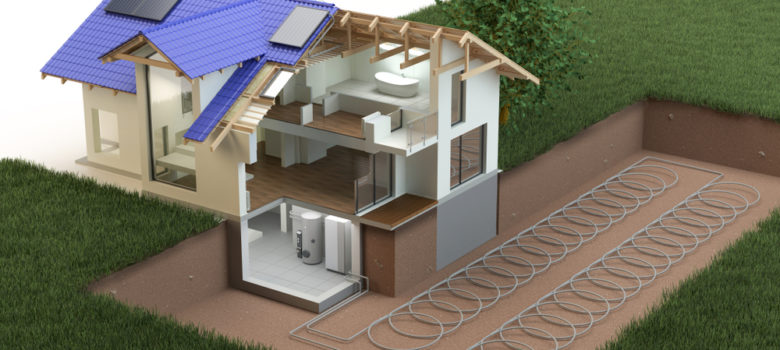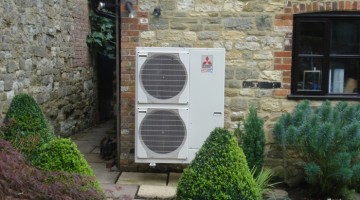
Whatever type of business you are in, cost control and sustainable practices will be important topics. So here’s an interesting proposition that could square the circle of reducing cost while increasing your long-term environmental commitment; installing a ground source heat pump (GSHP) in your commercial premises.
This type of renewable heating solution uses geothermal heat extracted from the ground (your commercial land) to provide your business with a viable alternative to traditional central heating systems, and provide considerable savings. So, how does this work?
Essentially, a ground source heat pump transfers heat from the ground to a building. Utilising a ‘ground loop’ (basically just a large loop of pipe) buried underground or through a body of water, the pump circulates a mixture of water and antifreeze through the pipework. The heat from the ground/water is absorbed into the mixture, then passed through a heat exchanger into the heat pump. The longer the loop, the more heat can be extracted.
The stored energy is then available for heating your commercial premises and/or to heat the hot water supply. Since the temperature in the ground remains fairly constant, GSHPs can be used all year round (unlike other types of heat pumps). This is far from being the only benefit of a GSHP; you can find out more here.
Commercial GSHPs work best in locations with a lot of land, such as agricultural businesses or farms, where there is good access for excavating machinery and ample space for a borehole or trench to be dug. If space is at a premium, vertical boreholes requiring only a small footprint may be more suitable, but these tend to raise the cost significantly.
Benefit 1: Lower heating costs
While installation costs for GSHP based heating systems may be higher than putting conventional central heating into the building, running costs will be significantly lower. It’s a cost-effective solution since lower levels of energy are needed to generate the same amount of heating.
In addition, as a business you can take advantage of the government’s Non-Domestic Renewable Heat Incentive (RHI) which covers GSHPs and will give you quarterly payments for your energy generation for a full 20 years. While precise amounts will be calculated according to the size and type of your GSHP system, it’s not unreasonable to expect an ROI of around 12% year on year, for the lifecycle of your renewable heating system.
Benefit 2: Robust heating performance
Once your new system is in place, you will find that GSHPs are very low maintenance indeed. The factory sealed units have an average 25-year lifespan, with highly efficient operation and negligible running costs amounting to a small amount of power to drive the compressor and circulation pumps.
While heat pump based systems can be used with many heating appliances, they perform best when teamed with large surface based heating apparatus. Underfloor heating, warm air heating systems or large surface radiators are ideal.
Benefit 3: No need for planning consent
Most cases of installing commercial ground source heat pump systems are likely to fall under permitted development rights, in which case there’s no need to obtain planning consent. That said, ‘permitted development’ comes with important limits and conditions that must be observed, so it is recommended that you check with the local planning office as a matter of course, and certainly before beginning any installation works.
Another advantage is that, given that the bulk of the apparatus is hidden underground, heat pumps are effectively invisible. Since they are automated, operate quietly and out of sight, with low maintenance and running costs, they might just be the perfect ‘fit and forget’ system. In terms of planning requirements, since there’s nothing to hear, see, or smell, this means that planning officers will rarely find a reason to object to an installation.
Benefit 4: Established technology
Far from being new technology, ground source heat pumps have been in use since the mid 19th century. In the 1970s, heat pump technology became a particular point of focus in Sweden. Commercial GSHP applications have been developing gradually ever since, with efficiency improvements and refinements having been implemented progressively.
Ground source heat pumps are routinely used as a renewable heating solution in countries around the world, including Sweden, Germany, Switzerland and across North America.
Benefit 5: Low carbon heating solution
Finally, it’s worth remembering what a large chunk of CO2 emissions arise as a result of heating/cooling our buildings. With a strong commitment towards using more environmentally friendly technologies gaining a firm foothold across UK businesses and homes, ground source heat pumps are an excellent way to burn less fuel and reduce emissions.
Better still, ground heat installations can be used both for heating and cooling, meaning you can do away with high carbon air conditioning systems. GSHPs provide sustainable energy by recycling heat between the seasons, so they can naturally cool buildings in the summer as well as heat them in the winter.












No Comments yet! Be the first one.